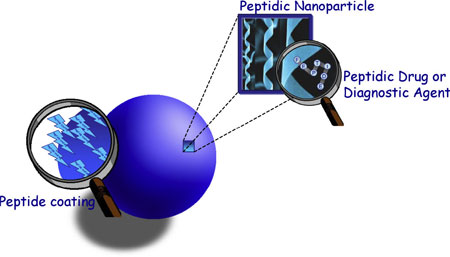| Posted: Jan 07, 2008 | |
Nanotechnology improves the prospect of better treatment for brain disorders |
|
| (Nanowerk Spotlight) 1,300 to 1,400 grams and several thousand kilometers of about 100 billion interconnected nerve cells control every movement, thought, sensation, and emotion that comprise the human experience. Within the brain and spinal cord there are ten thousand distinct varieties of neurons, trillions of supportive cells, a few more trillion synaptic connections, a hundred known chemical regulating agents, kilometers of minuscule blood vessels, and untold mysteries of how - almost flawlessly - all these components work together. This is the amazing brain (source: BrainSource.com). | |
| Given the incredible complexity of the brain, it doesn't come as a big surprise that a lot of things can go wrong. The A-Z of brain disorders is a very long list. Several of these disorders (such as Parkinson and Alzheimer disease, but also schizophrenia, epilepsy, and bipolar disorder), not to mention tumors, are so severe that they require treatment of the brain. | |
| But even when there are promising pharmaceutical compounds for their treatment, more than 98% of these potential agents do not reach the drug development stage. The reason is the blood-brain barrier (BBB), a tight seal of endothelial cells lines the blood vessels in the brain and acts as a barrier to protect its cells. BBB strictly limits transport into the brain through both physical (tight junctions) and metabolic (enzymes) barriers and keeps most substances, such as chemicals and large biomolecules, out of the brain. The combined use of peptides and nanotechnology offers tremendous hope in the treatment of brain disorders by offering a way for drugs (the therapeutic kind) across the BBB. | |
| The challenge in treating most brain disorders is overcoming the difficulty of delivering therapeutic agents to specific regions of the brain by crossing the BBB. The problem is that the BBB does not differentiate what it keeps out. With very few exceptions, only non-ionic and low molecular weight molecules soluble in fat clear the BBB. For instance, alcohol, caffeine, nicotine and antidepressants meet these criteria. However, large molecules needed to deliver drugs do not. | |
| In a recent review in the Journal of Peptide Science, Dr. Ernest Giralt from the Institute for Research in Biomedicine in Barcelona, Spain, together with Dr. Meritxell Teixidó from his group, summarized literature reports on the use of peptides and nanotechnology for the treatment and diagnosis of brain disorders, and comparing these approaches to other methods ("The role of peptides in blood-brain barrier nanotechnology"). | |
| "Over the past few decades, pharmaceutical technology has lead to the emergence of different nanosystems or nanoplatforms tailored to deliver drugs to the brain, including polymeric nanoparticles, liposomes, and solid lipid nanoparticles" Giralt tells Nanowerk. | |
| In their review, Teixidó and Giralt focus on the use of polymer matrix nanoparticles. These are solid colloidal particles which can carry therapeutic drugs or diagnostic agents complexed by adsorption, entrapment, or covalent attachment. The nanoscale of the particle may improve the transport properties and stability of the transported agent. Once the nanoparticle reaches the desired target, release can be achieved by one or more mechanisms such as desorption, diffusion, and nanoparticle erosion. | |
| Two nanoparticle applications are most promising for brain research and disorder treatment: the transport of MRI contrast agents to the brain to enable studying the central nervous system of patients; and for improved drug delivery across the BBB. | |
| "One of the most promising, yet challenging, applications of nanoparticles is the delivery of therapeutic peptides and proteins to the brain" says Giralt. "The main concern during the loading of nanoparticles with peptides or proteins is the chemical stability of the peptide or protein to the elevated temperatures, shear force, surfactants, free radicals, and UV radiation implied. Moreover, the function of proteins depends on their structure. Hence, the preparation needs to be optimized for each nanoparticle formulation." | |
 |
|
| The idea of an all-peptidic nanoplatform would put together the advantages that a peptidic nature can bring to every piece of this nanoplatform, in terms of mild synthetic conditions, potential to modulate the nanoplatform biodistribution, to increase its half-life in blood, and to improve its transport across the BBB. (Reprinted with permission from Wiley-VCH Verlag) | |
| The researchers note that the use of all-peptidic nanoplatforms – peptide nanoparticle, peptide coating, and peptidic drug or diagnostic agent – allows for mild conditions that do not affect the peptidic cargo. Another advantage of a peptidic coating is that it could be used to fine-tune an all-peptidic nanoplatform by modulating its biodistribution, increasing its half-life in blood, or improving its transport across the BBB by an endogenous mechanism. | |
| While the combined use of peptides and nanotechnology offers tremendous hope to address brain disorders by crossing the BBB. "Nonetheless" cautions Giralt, "the mechanisms of in vivo nanoplatform transport remain poorly understood. Moreover, nanoparticles, coatings and coadjuvants must be further studied for their potential effects on the structural integrity and function of the BBB." | |
 By
Michael
Berger
– Michael is author of three books by the Royal Society of Chemistry:
Nano-Society: Pushing the Boundaries of Technology,
Nanotechnology: The Future is Tiny, and
Nanoengineering: The Skills and Tools Making Technology Invisible
Copyright ©
Nanowerk LLC
By
Michael
Berger
– Michael is author of three books by the Royal Society of Chemistry:
Nano-Society: Pushing the Boundaries of Technology,
Nanotechnology: The Future is Tiny, and
Nanoengineering: The Skills and Tools Making Technology Invisible
Copyright ©
Nanowerk LLC
|
Become a Spotlight guest author! Join our large and growing group of guest contributors. Have you just published a scientific paper or have other exciting developments to share with the nanotechnology community? Here is how to publish on nanowerk.com.
